The Museum Collections
Introduction
I. History and Art Collection
1. Icons of the 14th – 19th centuries
icons of the 14th – 17th century
2. Jewelry art of the 14th – 20th century
jewelry art of the 14th – 17th century
jewelry art of the 18th – 19th century
the european silver 14th - 19th centuries
3. Small-size sculptures (works of metal, wood, bone)
XI – the beginning of the XX century
Small-size sculptures 11th – 17th century
Small-size sculptures 18th – early 20th century
enamel of Troitza masters 15-8th – early 20th century
5.Embroidery, lace, textiles of the 14th - early 20th century
icon and ornamental embroidery
gold and silver lace
6.Painting of the 18th – 21st centuries
painting of the 18th – 19th centuris
painting of the 20th – 21st centuris
II.Manuscripts and old printed books of the 14th – 17th century
IV.Lithography of the 18th – 19th century
V.Numismatics
VI.Medals of the 18th - early 20th century
VIII.Archeology collection
IX. Russian folk and applied and decorative art of the 17th – 21st c.
1. Artistic wood
folk carved and painted wood
wooden toys
house carving of Sergiev Posad
Khokhloma and Gorodets painting
2. Artistic textiles
embroidery and weaving
printed textiles and lace
Russian shawls
folk costumes
folk garments
printed cotton kerchiefs
|
The numismatics collection (p.4) |
The special place in numismatics of the Russian multinational state is occupied three long issued series of a "regional" coin created consideration local tradition and a habit of the population to certain coins.
The first attempt to create such coin has undertaken by Empress Elizabeth Petrovna in 1757, when stamping of special silver coins for Livland has begun. Named them simply – ‘livonetz”. On one party of livonetz - the portrait of the spouse of tsar Peter, empress Catherine I, the native of Latvia, and on another - the arms of Russian empire (Ill. 30). However, the coin has not been accustomed.
From 1804 to 1833 in Tiflis, for Georgia, which has just a part the Russian state, silver double abazes, abazes and semiabazes, and since 1810 - copper coins in 20, 10 and 5 bullets minted with a designation in the Georgian language (Ill. 31). The Russian-Polish coins zloties and pennies with an advantage designation in Russian and Polish languages were issued with 1815 on 1850 (Ill 32). In 1863 in Helsingfors, stamping of a series of gold, silver and copper coins for Finland has begun. It made gold in 20 and 10 marks, silver in 2 and 1 mark, 50 both 25 pennies and copper - in 10, 5 and 1 penny. Stamping proceeded untill 1917 (Ill. 33).
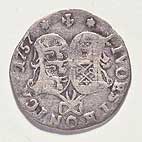
30. “Livonetz”. 1757. Silver.
|

31. Two abazes. 1820. The Half-abaze. 1821. Silver.
|
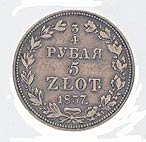
32. 3/4 rouble - 5 zloties. 1837. Silver.
|
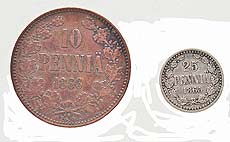
33. 10 pennies. 1866. Copper: 25 pennies. 1865. Silver
|
The general ruin, to which the imperialistic war begun in 1914 has finished economy of imperial Russia, has put an end to real existence of monetary system of Russian empire. In 1915, the silver rouble has minted last time. In the first year of war gold coins have completely disappeared, them have followed silver - at first large, and then and a trifle. Systematically since 1915, a paper of all colours superseded them. Even the place of a copper change occupied with note and stamps.
After revolution in the early 1920th, the Soviet government has created monetary system by a traditional Russian decimal principle during currency reform. The new silver coin in what did not concede pre-revolutionary one and in the opinion of the mullions-strong country population of the country was the most real and powerful proof of definitive overcoming of long-term frustration of monetary circulation.
The rouble and half-rouble coin of stamping 1921 and 1922 has the image of a five-pointed star on one party and the arms of the Russian Soviet Federal Socialist republic - on another. The same arms are on a change silver coin of stamping 1921-1923 at face-value 20, 15 and 10 kopecks (Ill. 34).
In 1924 at currency reform realization the coin of RSFSR of stamping 1921-1923 has been entered into currency, and coinage of the same face values was continue, but the new type, which has reflected declaration of the Union of the Soviet Socialist Republics. On the rouble 1924, that was decorate with the arms of the USSR is the image of the worker and the peasant. Next years the rouble was not mint any more. On a half-rouble coin, which was issued on 1927 with the image of the smith, face-value is designated «one fifty-kopeck piece». The kind of change has been updating also (Ill. 35-37).
|
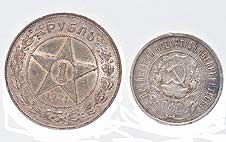
34. One Rouble (back). 1921; 50 kopecks (front). 1921. Silver.
|
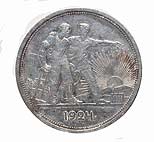
35. One Rouble (front). 1924. Silver.
|
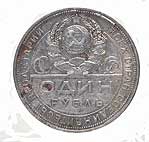
36. One Rouble (back). 1924. Silver. |
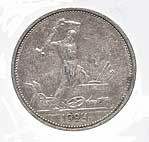
37. A fifty-kopeck piece. 1924. Silver.
|
Stabilization of the Soviet monetary economy in 1931 has allowed refusing at all dismiss of precious metal for the reference. Silver has been replaced nickel and sometimes by a bronze coin of new drawing. The type of a nickel and bronze coin of 1935 remained before reform of 1961. Last coin on chronology of our collection is dated 1955.
|


